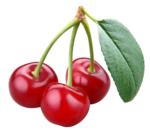University of California
The California Backyard Orchard
Cherry (Sweet: Prunus avium L; Sour: Prunus cerasus L.)
Two types of cherries can be planted: sweet, for fresh eating, and sour, for pies and preserves.
Generally, cherries are the most difficult trees to keep alive. They do not tolerate “wet feet” and are very susceptible to brown rot, bacterial canker, cytospora canker, root and crown rots and several viruses.
Trees must be planted 14–20 ft. apart in well-drained soil and up on a small mound or berm. Sweet cherries require cross-pollination (many varieties are self-sterile and intrasterile, as noted below), but sour cherries are self-fertile and do not require pollenizers. Both types require <100 days to mature.
Calendar of Backyard Gardening Operations for Cherries
Winter Dormant Season
- Spray with dormant oil to control San Jose scale.
- Prune 10% of last year’s growth on mature trees to let light in.
- Remove broken, diseased branches. Cherries may do better against bacterial canker (gummosis) if treated with fixed copper spray.
Spring Bloom Season
- Apply fungicide to control brown rot at popcorn and full bloom stages.
- Fertilize non-irrigated mature trees just before or during a rain with about 2 lb. urea or 70 lb. manure. Irrigated trees are fertilized just before an irrigation.
Spring/Summer Harvest Season
- Cover trees with bird netting to control birds.
- Drip irrigate daily. Sprinkler irrigate about every 2–3 weeks with 3–5” water/irrigation, depending on soil depth and water use.
- After harvest, fertilize mature trees with 2 lb. urea and water in immediately.
Summer/Fall Tree Growth
- Irrigate to maintain good tree vigor through summer heat and into fall until winter rain takes over.
- Drip irrigate daily to match daily use. Sprinkler irrigate every 3–4 weeks to wet all soil in root zone but stop September 1 to prevent root rot.
Resources
- Cherry Links, UC Fruit and Nut RIC
- [PDF] Cherry Varieties for Planting in the Home Garden, Paul Vossen and Deborah Silver, Sonoma and Marin Co. UCCE
- [PDF] Guidelines to Evaluate Cherries for Commercial Planting in the Sierra Nevada Foothills, Dick Bethell, El Dorado Co. UCCE
- [PDF] Harvest Time for Selected Fruit Cultivars in the Sacramento Valley Foothills, Janine Hasey, Sutter-Yuba Co. UCCE
- How to Manage Pests in Gardens and Landscapes - Fruits and Nuts, UC IPM
- [PDF] Cherry Crinkle-Leaf and Deep Suture Disorders, Steven M. Southwick, UC Davis Pomology and Jerry Uyemoto, USDA Plant Pathologist, UC Davis
- [PDF] Cherries: Calendar of Operations for Home Gardeners, Pamela M. Geisel and Carolyn L. Unruh, Fresno County and Paul Vossen, Sonoma and Marin County
- [PDF] Cherry Crinkle-Leaf and Deep Suture Disorders, Stephen M. Southwick
